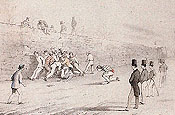| Resentment of football up to this time had been mainly for practical reasons. The game had been regarded as a public disturbance that resulted in damage to property, for example, in Manchester in 1608, football was banned again because so many windows had been smashed.
In the course of the 16th century a new type of attack was launched against football. With the spread of Puritanism, the cry went up against “frivolous” amusements, and sport happened to be classified as such, football in particular. The main objection was that it supposedly constituted a violation of peace on the Sabbath. Similar attacks were made against the theatre, which strait-laced Puritans regarded as a source of idleness and iniquity. This laid the foundations for the entertainment ban on English Sundays, which would later become a permanent feature during the Commonwealth and Puritanical eras (even though it is said that Oliver Cromwell himself was a keen footballer in his youth). From then on football on Sundays was taboo. It remained so for some 300 years, until the ban was lifted once again, at first unofficially and ultimately with the formal consent of The Football Association, albeit on a rather small scale. However, none of these obstacles could eradicate football. Take Derby as an example. Between 1731 and 1841, the town’s authorities made continual attempts to ban football from the streets. In the end, they had to resort to riot laws before there was any effect at all. All told there was scarcely any progress at all in the development of football for hundreds of years. But, although the game was persistently forbidden for 500 years, it was never completely suppressed. As a consequence, it remained essentially rough, violent and disorganised. A change did not come about until the beginning of the 19th century when school football became the custom, particularly in the famous public schools. This was the turning point. In this new environment, it was possible to make innovations and refinements to the game. The rules were still relatively free and easy as there was still no standard, organized form of the game. Each school in fact developed its own adaptation and, at times, these varied considerably. The traditional aspects of the game remained but innovations depended for the most part on the playing ground available. If use had to be made of a paved school playground, surrounded by a brick wall, then there was simply not enough space for the old hurly-burly mob football. Circumstances such as these made schools like Charterhouse, Westminster, Eton and Harrow give birth to the type of game in which more depended on the players’ dribbling virtuosity than the robust energy required in a scrum. On the other hand, schools such as Cheltenham and Rugby were more inclined towards the more rugged game in which the ball could be touched with the hands or even carried. All these early styles were given a great boost when it was recognised in educational circles that football was not merely an excuse to indulge in a childish romp, but could actually be beneficial educationally. What is more it was accepted that it also constituted a useful distraction from less desirable occupations, such as heavy drinking and gambling. A new attitude began to permeate the game, eventually leading to a “games cult” in public schools. This materialised when it was observed how well the team game served to encourage such fine qualities as loyalty, selflessness, cooperation, subordination and deference to the team spirit. Games became an integral part of the school curriculum and participation in football became compulsory. Dr. Thomas Arnold, the head of Rugby school, made further advances in this direction, when in 1846 in Rugby the first truly standardised rules for an organised game were laid down. These were in any event quite rough enough, for example, they permitted kicking an opponent’s legs below the knees, with the reserve that he should not be held still whilst his shins were being worked on. Handling the ball was also allowed and ever since the memorable occasion in 1823 when William Webb Ellis, to the amazement of his own team and his opponents, made a run with the ball tucked under his arm, carrying the ball has been permitted. Many schools followed suit and adopted the rules laid down in Rugby, others, such as Eton, Harrow and Winchester, rejected this form of football, and gave preference to kicking the ball and carrying it was forbidden. Charterhouse and Westminster were also against handling the soccer ball. However, they did not isolate their style as some schools did, instead they formed a nucleus from which this style of game began to spread.
Copyright and Source: FIFA History of the Game |
Soccer History Part 3
















